Alaska Fish & Wildlife News
March 2024
Moose-Vehicle Collisions in Alaska
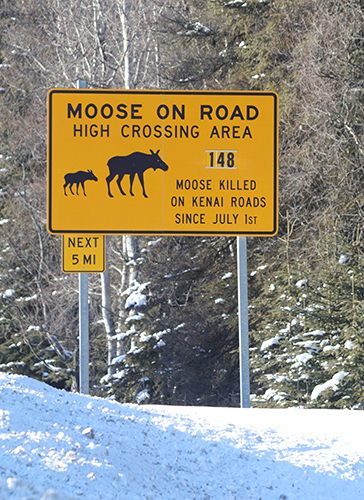
On a snowy day, a big cow moose is trudging down the shoulder of a Kenai Peninsula highway. A calf is behind her. The driver of an approaching car spots the pair and slows down, flashing her hazard lights as she passes to alert other drivers of the hazard.
When snow gets deep, moose find that plowed roadways offer easier access than back country trails. This puts them in danger from cars — and puts people in danger from moose and vehicle collisions.
In 2023, about 520 wildlife-involved crashes were reported to the Alaska State Troopers. In the previous two years there were even more — close to 670 wildlife-related collisions each year. Since not all moose-vehicle collisions are reported, it is likely that at least 800 vehicle accidents are caused by moose collisions throughout Alaska each year. Moose don’t usually survive a collision but sometimes they move away and die later.
Most of the documented collisions occur in the Matanuska-Susitna (31.6%) and the Kenai Peninsula (26.2%). Although moose-vehicle collisions can occur anytime of the year they are most frequent in winter when there is less daylight and winter storms can cause limited visibility. Between July 1, 2023, and Feb. 12, 2024, 148 moose have been killed on the Kenai Peninsula and 189 have been killed in the Matanuska-Susitna Valley.
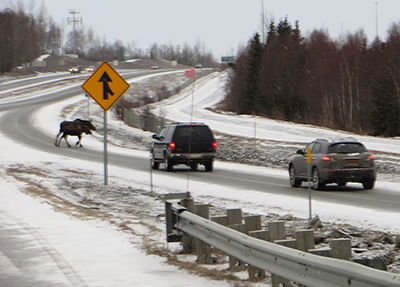
Call your local police department or 911 if you witness or are involved in a moose-vehicle collision, even if it seems minor.
Tips to avoid a moose-vehicle collision.
- Slow down, especially in bad weather, at night, or whenever visibility is reduced.
- Be alert! Scan both sides of the road for wildlife.
- Keep ample distance from other cars.
- Clean vehicle windows and headlights regularly to improve visibility when driving.
- Look for more moose. Cows often have calves nearby, though one or the other may not be visible from the road.
- Know the moose "hot spots" or local places where moose often cross the road, and watch for moose crossing signs.
- Use hazard lights! Know how to turn them on in any vehicle. Give them a flash while driving to warn other drivers anytime you observe wildlife on or near the road.
Moose-Vehicle Collision story map
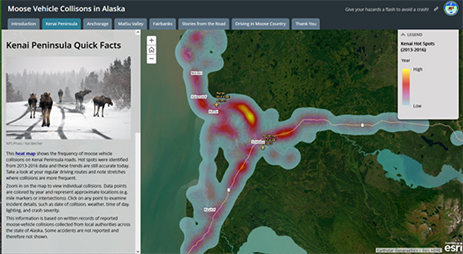
The Alaska Department of Fish and Game developed a Moose-Vehicle Collision story map which is an interactive tool that allows you to explore maps of Kenai Peninsula, Anchorage, Matanuska-Susitna Valley, and Fairbanks. These areas have the highest rates of moose-vehicle collisions, and the maps allow you to zoom into specific moose-vehicle collisions that occurred from 2013-2016 (and are still relevant today).
If you click on one of the dots on the webpage you can see dates, precise locations, weather, and more. To explore the roadkill hot spots, click here, then click on the upper tabs of the location where you are interested in exploring. Once you’ve explored the moose hotspots you can plan your trips more safely.
Kenai Peninsula Roadkill Moose.
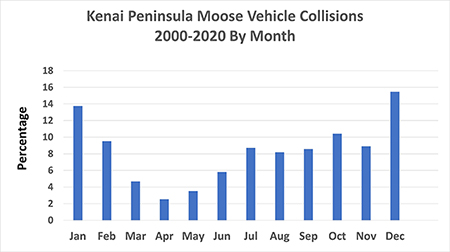
During a 20-year span (2000 – 2020), an average of 240 moose were killed every year on Kenai Peninsula roads. Fifty-one percent of the collisions involved calves, 42% involved cows, and 7% involved bulls. Calves that are killed by these collisions reduce the number of moose available for future harvest. Cows and female calves killed reduce the number of future calves.
What can we learn from Kenai Peninsula Roadkill Moose?
Almost 1,000 moose killed by vehicles on the Kenai Peninsula have been sampled by ADF&G wildlife biologists over the past ten years. The samples provide information about their physical condition when they were killed. They also help biologists to learn about the age structure of the living population, which predicts the potential for population growth. Biologists also look at bone marrow fat. Since this is the last fat reserve to be metabolized, low levels indicate malnutrition in an individual moose.
What happens to the roadkill moose meat?
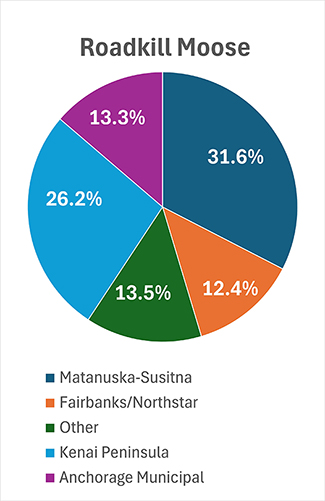
The Alaska Department of Public Safety keeps a list of salvage teams which recover animals for butchering and human consumption. When there is a roadkill moose it is provided to charity lists in different areas of the state for free. There is a list of qualifications for the Roadkill program that can be found here.
More about Kenai Peninsula Moose
click here for Kenai Peninsula Moose News.
Marian Snively works for ADF&G in Anchorage as part of the Wildlife Education and Outreach program within the Division of Wildlife Conservation.
Subscribe to be notified about new issues
Receive a monthly notice about new issues and articles.
